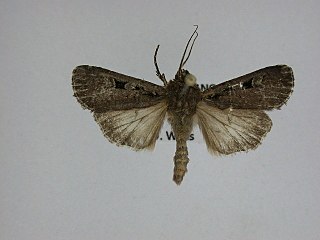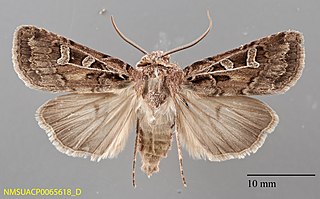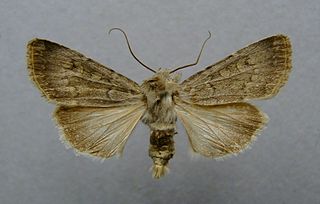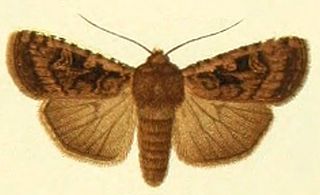
The white-line dart is a moth of the family Noctuidae. It is found from Europe, to southern Siberia, central Asia to the Pacific Ocean. In North Africa it is known from Morocco and Algeria.

Euxoa is a genus of moths of the family Noctuidae raised to Genus by the German entomologist, Jacob Hübner. The Genus is mostly confined to dry and semi dry areas in the Northern Hemisphere. There 130 species in Eurasia, a few in Africa, and 175 in North America. There are no species in the Genus in South-East Asia or in Australia. In North America, most species are found in Western regions. Of the North American species, 4 are endemic to Mexico. There is one species recorded from Chile, but this may be a mislabeled specimen. In real terms, species numbers do not equal species abundance. Some areas with few species have large numbers of the ones that do live there.

Euxoa messoria, the darksided cutworm or reaper dart, is a moth of the family Noctuidae. The species was first described by Thaddeus William Harris in 1841. It is found from Newfoundland west to Yukon, south to Virginia and Missouri in the east and New Mexico, Arizona and California in the west.

Euxoa recussa is a moth of the family Noctuidae. The nominate form is found in mountainous areas in Southern Europe as well as the Alps. Euxoa recussa tetrastigma is found Northern Europe, east to Russia, Western Siberia, the Altai Mountains and Amur.

Euxoa mimallonis is a species of moth of the family Noctuidae first described by Smith in 1890. It is found in North America from Nova Scotia west to coastal British Columbia, south in the east to Michigan and Minnesota, in the west to central California and New Mexico.
Euxoa campestris, the flat dart, is a moth of the family Noctuidae. The species was first described by Augustus Radcliffe Grote in 1875. It is found in North America from Newfoundland to Alaska, south to New England and southern Canada from southern Quebec west to British Columbia. In the west it is distributed southward in the Rocky Mountains to southern New Mexico, east-central Arizona, and central Utah. In the east it occurs in the Appalachians in eastern Kentucky and in western North Carolina.

Euxoa tessellata, the tessellate dart or striped cutworm is a moth of the family Noctuidae. It is the most widespread Euxoa-species in North America. It is found from Newfoundland to Alaska, south in the west to California, Arizona, New Mexico, south in the east to Florida. It seems to be absent from Texas and adjacent eastern states.

Euxoa adumbrata, the sordid dart, is a moth of the family Noctuidae. The species was first described by Eduard Friedrich Eversmann in 1842. In North America it is found across northern Canada from Quebec to western Alaska, south to the northern parts of the United States, and in the mountains to Colorado. It is also found in Greenland, the coastal areas of Scandinavia and the Ural. It was recently recorded from Denmark, although this includes Euxoa lidia, which some authors regard to be a valid species.
Euxoa declarata, the clear dart, is a moth of the family Noctuidae. The species was first described by Francis Walker in 1865. It is found in Canada in Ontario, Quebec, New Brunswick, Nova Scotia, Prince Edward Island, British Columbia, Alberta, Saskatchewan, Yukon and Manitoba. It is found as far west as central Alaska. In the United States it is also found to Minnesota and North Carolina in the east and Arizona, New Mexico and California in the west.

Euxoa divergens, the divergent dart, is a moth of the family Noctuidae. The species was first described by Francis Walker in 1857. It is found in North America from Newfoundland to Alaska, south to New York and Michigan in the east, and in the mountains of the west, south to New Mexico, Arizona and California.
Euxoa cicatricosa is a moth of the family Noctuidae first described by Augustus Radcliffe Grote and Coleman Townsend Robinson in 1865. It is found in North America from south central Saskatchewan west to southern interior British Columbia; south to southern California, Arizona, New Mexico and western Texas; east to western Nebraska and North Dakota.

Euxoa comosa, the hairy euxoa moth, is a moth of the family Noctuidae first described by Herbert Knowles Morrison in 1876. It is found in western North America, except the Pacific coast, ranging east through the northern Great Plains, and in the Hudsonian zone to the Atlantic Ocean. It is found in every province and territory of Canada, except Nunavut.
Euxoa dargo is a moth of the family Noctuidae first described by Strecker in 1898. It is found in North America from south-eastern Manitoba west to the southern interior of British Columbia, south to Oregon, southern Idaho and northern New Mexico, and east to eastern South Dakota.
Euxoa costata is a moth of the family Noctuidae. It is found in British Columbia, south into the north-western United States where it is abundant in the ponderosa pine forests east of the Cascade Mountains.

Euxoa eruta is a moth of the family Noctuidae. It is found in Italy, Spain, France, Germany, Denmark, Fennoscandia, Austria, Switzerland, Hungary, Bulgaria, the Czech Republic, Greece, Turkey, Belarus, the Baltic region, Siberia and from central Asia up to the Altai Mountains. Note that E. eruta may not be a good species. The Euxoa tritici complex consists of five sibling species in Europe: Euxoa tritici, Euxoa nigrofusca, Euxoa eruta, Euxoa diaphora Boursin, 1928 and Euxoa segnilis. Furthermore, although Fibiger (1997) treated Euxoa montivaga differently it belongs to the E. tritici complex. Differences among the species are subtle, the most important diagnostic characteristics being genitalic. In studies of three of these species, E. tritici, E. nigrofusca and E. eruta, no support was found for the presence of several morphologically distinguishable species with quantitative morphometric analyses.

Euxoa edictalis is a moth of the family Noctuidae first described by Smith in 1893. It is found in North America from south central Alberta and east-central Montana, west to south-central British Columbia, south to central California, southern Nevada, central Utah and western Colorado.

Euxoa aquilina is a moth of the family Noctuidae. It is found in the Mediterranean region of Europe, North Africa, the Near East and the Middle East.

Euxoa decora is a moth of the family Noctuidae. It is found in southern and central Europe, Morocco, Algeria, the Caucasus, Armenia, Issyk-Kul, Turkey, Iran and Iraq.

Euxoa hastifera is a moth of the family Noctuidae. It is found from southern Europe to Siberia and Tajikistan.

Euxoa ochrogaster, the red-backed cutworm, is a moth of the family Noctuidae. It is found from Iceland and northern Europe, through the Baltic to the Amur region. In North America, it is found from Alaska to Newfoundland and Labrador, south into the northern part of the United States, south in Rocky Mountains to Arizona and New Mexico.












